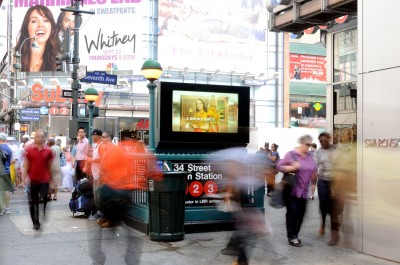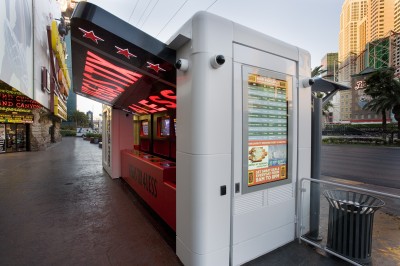Wind
The digital display and its mounting structure must be designed to withstand local wind loads, which might include gale winds and hurricane forces. A wind load can certainly reach 225 km/h (140 mph).
Vandalism
To contend with vandalism, the digital display will need breakage-resistant, replaceable cover safety glass. (Some types are ballistic-resistant.) That way, the glass can be replaced without needing to replace the LCD. Displays that are optically bonded to their cover glass should be avoided.

In bustling cities like New York, N.Y., an outdoor display will be prone to heavy amounts of dust, dirt and other airborne particulate matter, including brake dust and fumes from passing vehicles.
Proximity sensors can be added, so as to sound an alarm when a vandal strikes. Sensors can also be added to the ‘doors’ of the display’s casing, so an alarm goes off specifically when someone tries to open it.
Sealing a unit properly will also protect it from insects and rodents.
Public space
Another difference between indoor and outdoor digital signage deployments is that of private and public space. An outdoor installation may require a municipal, regional or provincial permit—and will probably need to be certified by a professional engineer. Unions and safety personnel might also be required for both installation and subsequent service.
Servicing and maintenance should be made as easy as possible, since repairs may need to be conducted in cold, rainy and/or windy conditions. Modular replacement components will help accelerate such work.

Screens installed in ‘street furniture’ may be subject to vandalism. In this example, security cameras were added to the structure.
Bylaws can also mean restrictions on full-motion video content for digital displays, particularly when screens face traffic, as well as on audio content. It is important to check local codes before determining what the nature of a new display’s content will be.
Many outdoor digital signs will transition between static images, for example, rather than display video. There may be restrictions that affect the frequency of these transitions (e.g. allowing changes only every 10, 15 or 30 seconds).
Local codes could also determine whether or not an outdoor digital display needs to be automatically dimmed or even shut down at night, generally after 11 p.m.
When choosing a location for an outdoor display installation, it is also important to determine how the power supply and data connectivity will be achieved. Power will need to be run to the unit. Displays with a universal power supply of 85 to 265 V are recommended, keeping in mind that due to their brightness and other aforementioned factors, an outdoor display will consume three to five times more power than an indoor one. Summer could bring brownout conditions if the current draw spikes and trips the circuit breakers.





